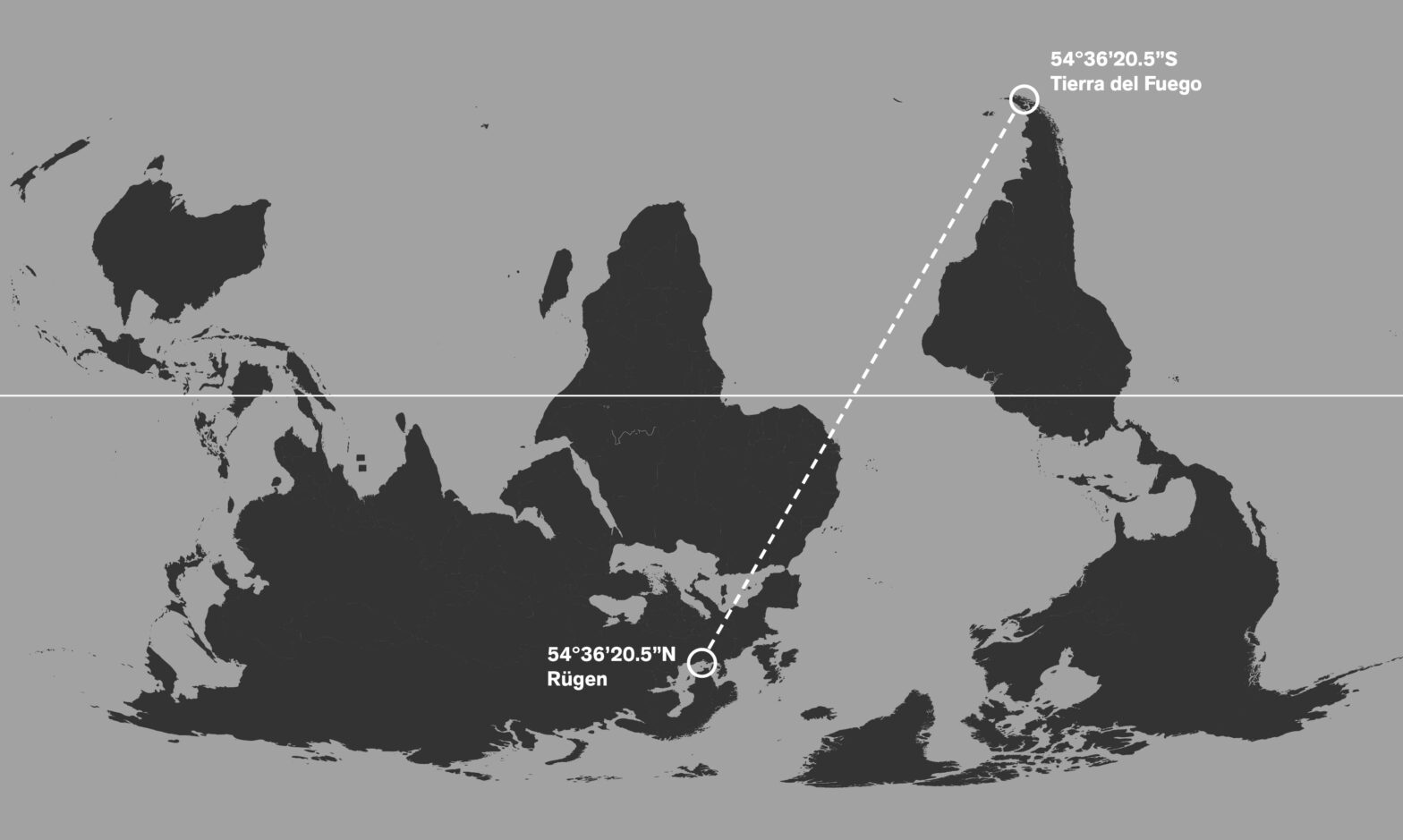Mirrored perceptions between Tierra del Fuego + Rügen
March and September 2023
Objects in mirror are closer than they appear
(unknown automobile producer)
Important for the Terra Ignota project is the aspect of mediation. How can this artistic-scientific knowledge production be translated for a wider audience? What are suitable formats for public presentation? How can results be transported to other geographical locations or in other cultural contexts without themselves being extractivist?
For us, this can only be sustainably developed through an intensive exchange between the international partners and, above all, through a constant critically adjusted practice on both sides. While we were thinking about scenarios and how to develop manifestations of that approach, we noticed some striking similarities between our different places of origin.
If you mirror the globe, you will find Germany’s largest island, Rügen, at almost exactly the opposite position of Tierra del Fuego. Both lie at precisely the same latitude. (54°36’20.5 “S Tierra del Fuego / 54°36’20.5 “N Rügen). A closer look reveals many similarities in geography and landscape, climate, flora and fauna, history and archaeology, culture and even recent social and demographic dynamics.
The Fuegians, indigenous groups of Selk’nam, Yagan, Kawesqar and Haush, settled Tierra del Fuego. Coming from the north with the great global migratory movements, they inhabited the southern cone for more than 10.000 years as nomadic hunter-gatherer communities. The colonization (settlements, sheep farming, wood cutting, local gold rush), and the systematic displacement and genocide didn’t occur until the second half of the nineteenth century. Early ethnographers were still able to observe their pre-colonial culture before the entire population nearly became extinct. The dramatic ecological, demographic and cultural effects of civilisational developments over the last 100 years are clearly visible throughout Tierra del Fuego.
On Rügen, similar historical developments can be observed with a time difference of a few centuries. Numerous megalithic tombs and a wealth of archaeological findings attest to settlement since the Stone Age. Owing to rich flint deposits, Rügen was an important centre for the production and trade in stone tools. Due to very rich Terminal Mesolithic (5000-4000BC) artifact findings in the area around Lietzow-Buddelin, the term Lietzow Culture was coined.This culture was related to the Ertebølle Culture of the Scandinavian region which is similar to the Shell Midden Culture in Tierra del Fuego. During the 1st century, Rügen was inhabited by the tribe of the Rugii or Rygir (Rye Eaters), who had most likely migrated from the Scandinavian region. From the 7th century onwards, Slavic immigrants from the Rani (or Rujani) tribe settled on Rügen and remained there until the Danes landed in 1168 and christianised the islanders. The more recent changes, from a former calm and remote island with local agriculture to a busy seasonal touristic hotspot, feels uncannily like what one might expect to unfold on Tierra del Fuego in the near future.
Apart from the historical and cultural dimensions, there are great similarities in the geological development and formation by glacial periods – again with a time difference. The retreat of glacier formations in Tierra del Fuego today is a very precise indicator of global warming in recent decades, the erosion caused by persistent drought and soil depletion on Rügen is yet another sign of human activity fast tracking ecological change. Although the Baltic and Southern Seas differ, they are also both home to porpoises and seals, and forced to address similar problems: increased littering, eutrophication, lack of phytoplankton, overfishing, pollution from concentrated fish farming or the direct effects of fossil fuel extraction and transit.
Both places face rapid changes in the near future due to current global developments and shifts in geo-political dynamics. (The race to Antarctica in Tierra del Fuego or the New Silk Road connection and long term LNG terminal infrastructure developments on Rügen)
SONIC ISLANDS focuses on the various auditory aspects of the TERRA IGNOTA project and is part of TIF 2023/24.
We are interested in the meaning of sound as a semantic system and as a form of artistic articulation. Questions about origin, identity, intercultural understanding but also about perception, legibility and interaction with the environment, social processes and structures beyond visually connoted reference systems are the subject of our joint research. Listening and making audible to stimulate changes of perspective in the process of artistic research and knowledge production as well as in communicating to an audience.
The research process started in Tierra del Fuego (March 2023) was continued on the geographically and culturally mirrored island of Rügen (September 2023). The results are presented on the opposite sides in the different local contexts – literally drawing a straight connecting line through the globe.
The reflection proved to be extremely productive. Beyond the similarities mentioned above, the residency process brought to light some very surprising connections that we had not anticipated – connecting once again with the pressing questions of our time. The project blog is documenting some of the findings, new connections and observations and shows some concrete site-specific sound installations, interventions, performances and activities.
Presentations:
Friday September 15th presentations at different locations on Rügen (Kap Arkona, Binz and Neukamp)
Tuesday September 19th open studio at liebig12 in Berlin 4 – 10pm
March 2024 final exhibition of the TERRA IGNOTA FORUM at UMAG, Punta Arenas
The project was funded by the Goethe Institut International Coproduction Funds and Musikfonds e.V. and support by Universidad Nacional de San Martin.

